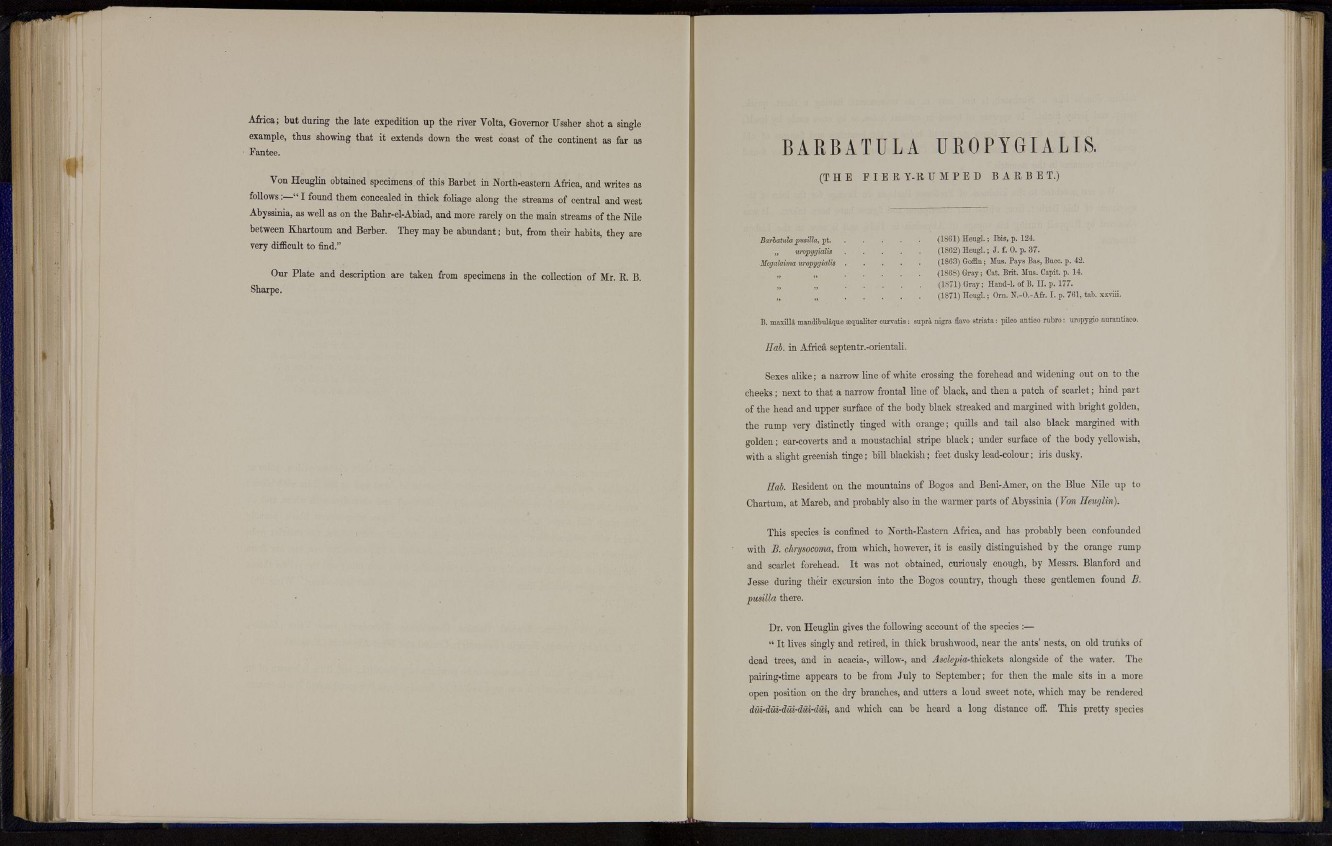
Africa; but during the late expedition up the river Volta, Governor Ussher shot a single
example, thus showing that it extends down the west coast of t h e continent as far as
Fantee.
Von Heuglin obtained specimens of this Barbet in North-eastern Africa, and writes as
follows:—" I found them concealed in thick foliage along the streams of central and west
Abyssinia, as well as on t h e Bahr-el-Abiad, and more rarely on the main streams of the Nile
between Khartoum and Berber. They may be abundant; but, from their habits, they are
very difficult to find."
Our Plate and description are taken from spécimens in the collection of Mr. B. B.
Sharpe.
B A R B A T U L A TJROPYGIALIS.
( T H E F I E R Y - R U M P E D B A B B E T.)
Barbatula pusilla, pt (1801) Heugl.; Ibis, p. 124.
„ uropygialis (1802) Heugl.; J. f. 0. p. 37.
Megalaima uropygialis (1803) Goffin; 3lus. Pays lias, Bucc. p. 42.
(1868) Gray; Cat. Brit. l l u s . Capit. p. 14.
(1871) Gray; Hand-1. of B. I I . p. 177.
(1871) Heugl.; Orn. N.-O.-Afr. I. p. 761, tab. xxviii.
B. maxilla mandibulaque a;qualitcr curvatis : supra nigra flavo striata: pilco antico rubro: uropygio aurantiaco.
Hub. in Africa septentr.-orientali.
Sexes alike; a narrow line of white crossing the forehead and widening out on to t he
cheeks; next to that a narrow frontal line of black, and then a patch of scarlet; hind part
of the head and upper surface of the body black streaked and margined with bright golden,
the rump very distinctly tinged with orange; quills and tail also black margined with
golden; ear-coverts and a raoustachial stripe black; under surface of t h e body yellowish,
with a slight greenish tinge; bill blackish; feet dusky lead-colour; iris dusky.
Uab. Resident on the mountains of Bogos and Beni-Amer, on t h e Blue Nile up to
Chartum, at Mareb, and probably also in the warmer parts of Abyssinia (Von Heuglin).
This species is confined to North-Eastern Africa, and has probably been confounded
with B. chrysocoma, from which, however, it is easily distinguished by the orange rump
and scarlet forehead. It was not obtained, curiously enough, by Messrs. Blanford and
Jesse during their excursion into the Bogos country, though these gentlemen found B.
pusilla there.
Dr. von Heuglin gives the following account of the species :—
" I t lives singly and retired, in thick brushwood, near the ants' nests, on old trunks of
dead trees, and in acacia-, willow-, and Asclejua-thickets alongside of the water. The
pairing-time appears to be from July to September; for then the male sits in a more
open position on the dry branches, and utters a loud sweet note, which may be rendered
dui-dui-dui-dui-dui, and which can be heard a long distance off. This pretty species